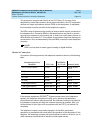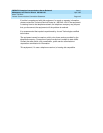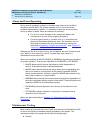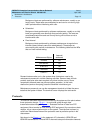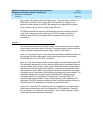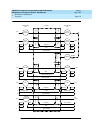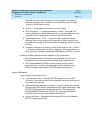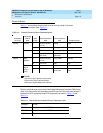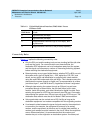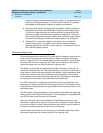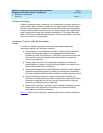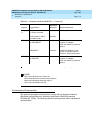
DEFINITY Enterprise Communications Server Release 5
Maintenance and Test for R5vs/si
555-230-123
Issue 1
April 1997
Maintenance Architecture
Page 1-6Protocols
1
Usage
The following is a list of the protocols when data is transmitted to and through the
system. The list is organized by protocol layers. Refer to Figure 1-1
.
Layer-1 Protocols
Layer-1 protocols are used between the terminal or host DTE and the DCE, used
between the DCE equipment and the system port, and used inside the system.
The following layer-1 protocols are used between the DTE equipment and the
DCE equipment. DCE equipment can be data modules, modems, or Data
Service Units (DSUs). A DSU is a device that transmits digital data to a particular
digital endpoint over the public network without processing the data through any
intervening private network switches.
■
RS-232
— A common physical interface used to connect DTE to DCE.
This protocol is typically used for communicating up to 19.2 kbps
■
RS-449
— Designed to overcome the RS-232 distance and speed
restrictions and lack of modem control
■
V.35
— A physical interface used to connect DTE to a DCE. This protocol
is typically used for transmissions at 56 or 64 kbps
The following protocols are used at layer 1 to govern communication between the
DCE equipment and the port. These protocols consist of codes inserted at the
originating DCE and stripped at the port. The DS1 protocol can be inserted at the
originating, outgoing trunk port and stripped at the destination port.
■
Digital Communications Protocol (DCP)
— A standard for a 3-channel
link. This protocol sends digitized voice and digital data in frames at 160
kbps. The channel structure consists of two information (I) channels and
one signaling (S) channel. Each I-channel provides 64 kbps of voice
and/or data communication and the S-channel provides 8 kbps of
signaling communication between the system and DTE equipment. DCP is
similar to ISDN-BRI
■
Basic Rate Interface (BRI)
— An ISDN standard for a 3-channel link,
consisting of two 64-kbps bearer (B) channels and one 16-kbps signaling
(D) channel. For the implementation of this standard, see
DEFINITY
Communications System and System 75 and System 85 ISDN BRI
Reference
, 555-025-103
■
Primary Rate Interface (PRI)
— An ISDN standard that sends digitized
voice and digital data in T1 frames at 1.544-Mbps or, for countries outside
the United States, in E1 frames at 2.048-Mbps. Layer 1 (physical), layer 2
(link), and layer 3 (network) ISDN PRI protocols are defined in
AT&T
System 75 and 85
—
DS1/DMI/ISDN-PRI
—
Reference Manual
,
555-025-101. At 1.544 Mbps, each frame consists of 24 64-kbps channels
plus 8 kbps for framing. This represents 23 B-channels plus 1 D-channel.



